Park View Hotel, Exeter, Thursday evening and Friday morning, 17-18 August 2000
There is a good deal of catching up to do since my last entry.
We arrived in Bath, amid showers, on Sunday, and started with the Jane Austen center. The tour there began with about fifteen minutes' lecture. The collection seemed to me a bit thin, and they had had to settle for a house down the street from one where the novelist had at one time briefly and none too contentedly lived. Not surprisingly the children were less than thrilled, but then I told them this was for Stas and me, and they were game enough and well behaved.
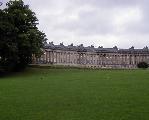
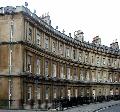 Next day, with somewhat better weather, we did the round of standard sights, starting with the Royal Crescent (left) and the Circus (right). Both of these are rows of elegant Georgian town houses in Bath sandstone, in the form of a semicircle and a full circle designed by John Wood fils and père respectively.
Next day, with somewhat better weather, we did the round of standard sights, starting with the Royal Crescent (left) and the Circus (right). Both of these are rows of elegant Georgian town houses in Bath sandstone, in the form of a semicircle and a full circle designed by John Wood fils and père respectively.
 These are merely the best known and most shining examples of the city's remarkably coördinated architecture. The whole town is full of almost equally elegant rows of townhouses and public buildings of the same material, period, and general style, notably including Queen Square (left) near our lodging. This fortunate coherence results from Bath's meteoric transformation into a great center of fashionable and moneyed society in the eighteenth century. Various literary observers of the town from Sheridan to Austen and beyond characterized fashionable Bath society of the period as vain and shallow, and I see not the slightest reason to doubt that characterization; but even if the moneyed gentry of the period were generally a contemptible lot, the architecture their money bought was anything but.
These are merely the best known and most shining examples of the city's remarkably coördinated architecture. The whole town is full of almost equally elegant rows of townhouses and public buildings of the same material, period, and general style, notably including Queen Square (left) near our lodging. This fortunate coherence results from Bath's meteoric transformation into a great center of fashionable and moneyed society in the eighteenth century. Various literary observers of the town from Sheridan to Austen and beyond characterized fashionable Bath society of the period as vain and shallow, and I see not the slightest reason to doubt that characterization; but even if the moneyed gentry of the period were generally a contemptible lot, the architecture their money bought was anything but.
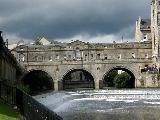

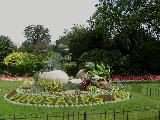 Later on our Monday tour we went to see the splendid Assembly Rooms with original eighteenth-century glass ballroom chandeliers; the Pulteney Bridge (far left), and the very late gothic abbey church (near left); and of course the celebrated and very impressive Roman Baths, excavation and exhibition of which had notably advanced since my first visit. We also visited the Parade Gardens, in which we discovered a formerly elegant (but now none too clean) colonnade directly beneath the river-side Grand Parade, as well as the neo-Cretaceous floral sculpture shown at right, and the vantages for both of the photos at left.
Later on our Monday tour we went to see the splendid Assembly Rooms with original eighteenth-century glass ballroom chandeliers; the Pulteney Bridge (far left), and the very late gothic abbey church (near left); and of course the celebrated and very impressive Roman Baths, excavation and exhibition of which had notably advanced since my first visit. We also visited the Parade Gardens, in which we discovered a formerly elegant (but now none too clean) colonnade directly beneath the river-side Grand Parade, as well as the neo-Cretaceous floral sculpture shown at right, and the vantages for both of the photos at left.
As we waited for our laundry Tuesday morning we visited first a shop and then the studio of Bath Aqua Glass. This outfit has revived a local glass-blowing tradition of the Roman days, with glass tinted light blue by locally occurring copper sulfate, and designs in many cases modeled on ancient pieces. Trevor in particular was hugely taken by the sight of the glass-blowers' art, and talked all day of the things he would make us of glass as soon as he learned how.
The rest of Tuesday was a decidedly bad day in the automotive department. On our way out of Bath, after a couple of wrong turns, we had a collision while attempting a U-turn. Fortunately no one was hurt, both vehicles came out of it fully operational though rather disfigured, and no one got in the least surly; but of course it strained nerves and made for a fairly substantial delay. Later on, by Bridgwater in Somerset, I filled the fuel tank for the first time since we picked the car up in Chester. Soon afterwards I noticed pronounced loss of power and in a little under five miles it stalled out right smack in the middle of a roundabout (a traffic circle at a fairly major intersection), and would not start again. A couple of good Samaritans helped push it to a spot where it would not obstruct traffic, and one of them also allowed me to place a cellular call to the car rental company for help. We also managed to diagnose the problem: inside the flap covering the fuel tank cap, if and only if one stooped down behind it while it was open, the word DIESEL was clearly visible. (This was altogether news to me, the rental agent having never breathed a word of warning, and no manual having been present in the glove box.) We waited an hour for a tow truck, backtracked for miles inside it, and waited about an hour more while a mechanic drained the tank and flushed the lines and engine.
At this point it was past the children's bedtime and we had not even had dinner, though the children had been gallant and cheerful throughout. Bad advice on where to get some dinner at that hour led us back on our tracks yet further, till we found a tavern (not the place we were directed for) that was very nice and suitable, except that I could not help noticing that a couple of young professional women had staked out tables in the bar area for entertaining prospective clients. We finally reached our place for the night--a thirteenth-century thatched inn that I had been looking forward to--within a half hour of midnight.
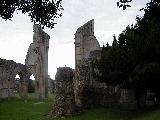
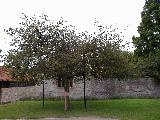 In between our two automotive mishaps we paid a visit to the ruins of the vast abbey church at Glastonbury, where Joseph of Arimathea supposedly brought the Grail and where Arthur and Guinevere are supposedly buried (where you see the small signpost in the ground in the photo at left). The holy thorn tree there (right) reputedly springs from Joseph's staff that took root when he arrived and became a living tree blooming every Christmas. Museum placards at the visitors' center seemed decidedly hostile to Henry VIII, which I thought a bit odd since his sometimes violent "dissolution" of the monasteries including this one was part of his establishing the Church of England, which remains the established church in this country. Unfortunately neither weather nor time suited for attempting the ancient hillside maze of Glastonbury Tor.
In between our two automotive mishaps we paid a visit to the ruins of the vast abbey church at Glastonbury, where Joseph of Arimathea supposedly brought the Grail and where Arthur and Guinevere are supposedly buried (where you see the small signpost in the ground in the photo at left). The holy thorn tree there (right) reputedly springs from Joseph's staff that took root when he arrived and became a living tree blooming every Christmas. Museum placards at the visitors' center seemed decidedly hostile to Henry VIII, which I thought a bit odd since his sometimes violent "dissolution" of the monasteries including this one was part of his establishing the Church of England, which remains the established church in this country. Unfortunately neither weather nor time suited for attempting the ancient hillside maze of Glastonbury Tor.
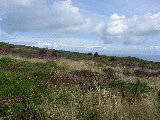 The next morning we slept in a little later than usual before getting on our way, starting with the ascent of Porlock Hill. This, the early British motorists' answer to Pike's Peak, was only the first of many steep and ear-popping hills on the road along the coast of Exmoor, since it kept passing back and forth between the moor (by definition upland) and the coastal towns and villages.
The next morning we slept in a little later than usual before getting on our way, starting with the ascent of Porlock Hill. This, the early British motorists' answer to Pike's Peak, was only the first of many steep and ear-popping hills on the road along the coast of Exmoor, since it kept passing back and forth between the moor (by definition upland) and the coastal towns and villages.
 We stopped at Clovelly, where we started lunch at the cafeteria of a large visitors' center through which all visitors to the village now pass. We were driven away from both our lunch and the picture-postcard "English Heritage" village (which we never even got to see, though I had seen it once before) by numerous yellow wasps. Stas is dangerously allergic to insect stings. At least Ariadne got a donkey ride there.
We stopped at Clovelly, where we started lunch at the cafeteria of a large visitors' center through which all visitors to the village now pass. We were driven away from both our lunch and the picture-postcard "English Heritage" village (which we never even got to see, though I had seen it once before) by numerous yellow wasps. Stas is dangerously allergic to insect stings. At least Ariadne got a donkey ride there.
Fortunately, stinging insects were not out in force at Tintagel, the spectacular Cornish headland with its ruined castle and legendary status as Arthur's birthplace. Stas and I thought the place quite on a par with Malin Head in Donegal in terms of scenery, though Malin Head had the distinct advantage of not being so overrun with our fellow tourists.
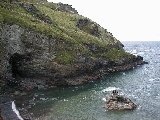
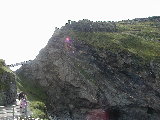
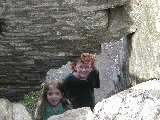
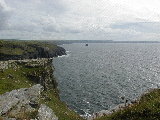

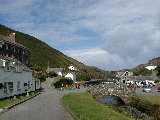
 Our overnight was in Boscastle, just a few miles back east from Tintagel. The next morning (Thursday) we drove down to view its little harbor. Stas and the children toured the Museum of Witchcraft there. This would seem to be a major collection in its limited field, presented I gather from the standpoint of Wicca, a twentieth-century neo-pagan movement with persistent pretensions to antiquity.
Our overnight was in Boscastle, just a few miles back east from Tintagel. The next morning (Thursday) we drove down to view its little harbor. Stas and the children toured the Museum of Witchcraft there. This would seem to be a major collection in its limited field, presented I gather from the standpoint of Wicca, a twentieth-century neo-pagan movement with persistent pretensions to antiquity.
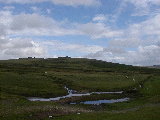 Leaving Boscastle we headed here for Exeter, not by the quickest route but rather by way of the heart of Dartmoor, the mooriest of English moors and setting for the great Sherlock Holmes novel The Hound of the Baskervilles.
Leaving Boscastle we headed here for Exeter, not by the quickest route but rather by way of the heart of Dartmoor, the mooriest of English moors and setting for the great Sherlock Holmes novel The Hound of the Baskervilles.
previous entry
next entry
main/ToC page

 Next day, with somewhat better weather, we did the round of standard sights, starting with the Royal Crescent (left) and the Circus (right). Both of these are rows of elegant Georgian town houses in Bath sandstone, in the form of a semicircle and a full circle designed by John Wood fils and père respectively.
Next day, with somewhat better weather, we did the round of standard sights, starting with the Royal Crescent (left) and the Circus (right). Both of these are rows of elegant Georgian town houses in Bath sandstone, in the form of a semicircle and a full circle designed by John Wood fils and père respectively.















